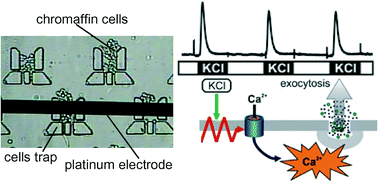A microfluidic platform for chemical stimulation and real time analysis of catecholamine secretion from neuroendocrine cells
Abstract
Release of neurotransmitters and hormones by calcium-regulated exocytosis is a fundamental cellular process that is disrupted in a variety of psychiatric, neurological, and endocrine disorders. As such, there is significant interest in targeting neurosecretion for drug and therapeutic development, efforts that will be aided by novel analytical tools and devices that provide mechanistic insight coupled with increased experimental throughput. Here, we report a simple, inexpensive, reusable, microfluidic device designed to analyze catecholamine secretion from small populations of adrenal chromaffin cells in real time, an important neuroendocrine component of the sympathetic nervous system and versatile neurosecretory model. The device is fabricated by replica molding of polydimethylsiloxane (PDMS) using patterned photoresist on silicon wafer as the master. Microfluidic inlet channels lead to an array of U-shaped “cell traps”, each capable of immobilizing single or small groups of chromaffin cells. The bottom of the device is a glass slide with patterned thin film platinum electrodes used for electrochemical detection of catecholamines in real time. We demonstrate reliable loading of the device with small populations of chromaffin cells, and perfusion/repetitive stimulation with physiologically relevant secretagogues (carbachol, PACAP, KCl) using the microfluidic network. Evoked catecholamine secretion was reproducible over multiple rounds of stimulation, and graded as expected to different concentrations of secretagogue or removal of extracellular calcium. Overall, we show this microfluidic device can be used to implement complex stimulation paradigms and analyze the amount and kinetics of catecholamine secretion from small populations of neuroendocrine cells in real time.


 Please wait while we load your content...
Please wait while we load your content...